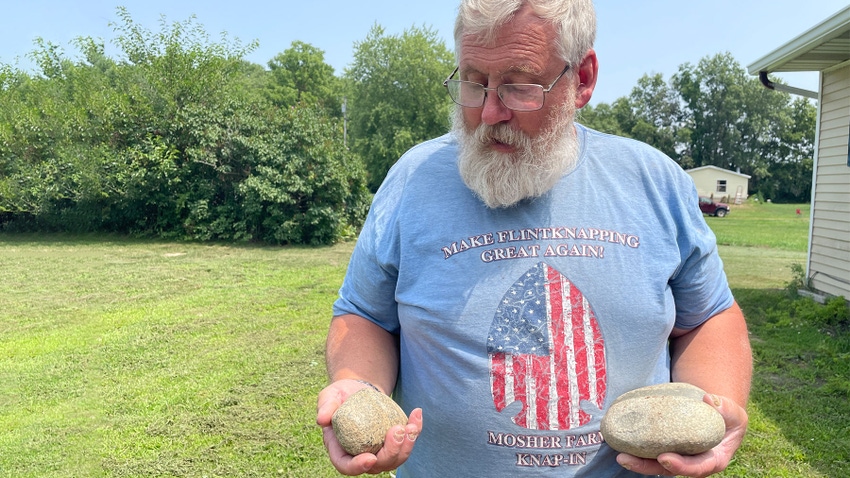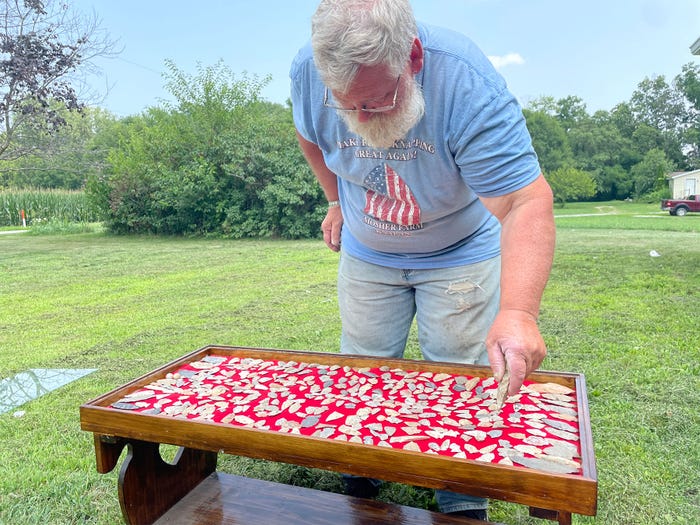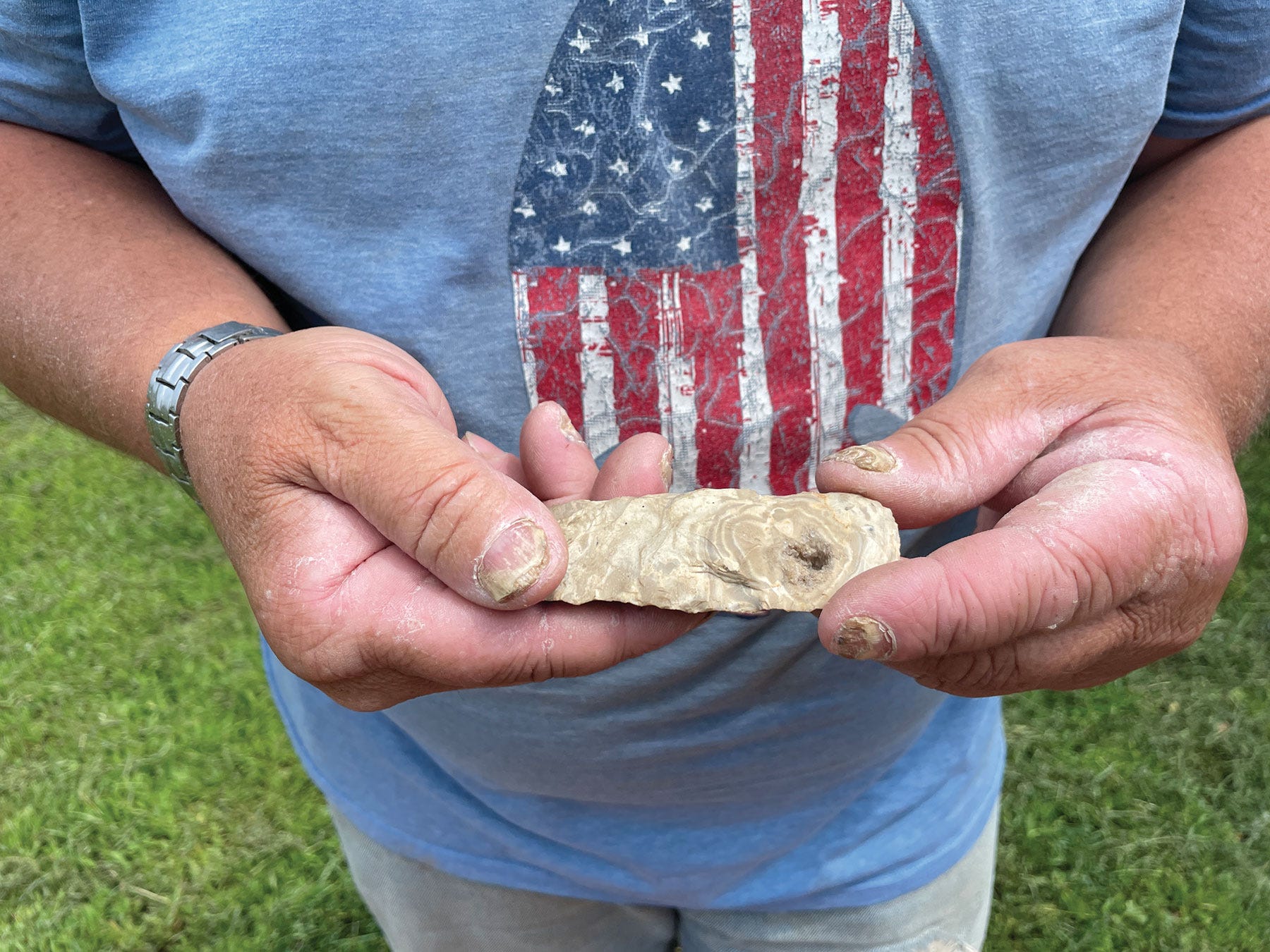August 9, 2023

by Allison Lund
A core memory for many farm kids and adults alike is stumbling upon an arrowhead while walking through a field. Those who are lucky, or who have an eye for these artifacts, are able to build a collection of them throughout their lives.
Native American artifacts are treasured pieces of history that can give an idea of how those individuals worked, hunted and survived. These artifacts display a high quality of craftsmanship and give folks opportunities to learn and better understand a different culture and way of life.
Some examples of artifacts that have been found in Indiana are arrowheads, spearpoints and a wide variety of pottery. These pieces can also be used as diagnostic tools; they help researchers determine the time period they were from. North America has a 12,000- to 15,000-year pre-history, and artifacts can be found from throughout that timeline.
Certain spearpoints can be found throughout Indiana, Illinois, Wisconsin and other surrounding areas because they were the popular style of the time period.
“When you look at projectile points in Wisconsin and Illinois and Indiana, we find the same projectile points being used throughout the region,” explains Kurt Sampson, professional archaeologist. “But they might have slightly different names attached to them based on how they were identified in those specific regions.”
Sampson also shares that Native Americans from different regions traded their tools, so some region-specific tools may be found in other states, even though the materials to make them are not found there.
“During the entire span of pre-history, there were elaborate trade networks that were developed across the Eastern United States where we will find stone material that does not occur naturally in the geological record of the state,” Sampson adds.
When it comes to identifying spearpoints, there are 60 different morphological attributes that can be examined. Some of these include size, shape and side notches.
How to look for artifacts
Sampson’s best advice for searching for artifacts is to put yourself in the shoes of the Native American who created those tools.
“You have to think about human nature and how people are,” Sampson says. “People always need water, no matter what, so you have to think like a hunter-gatherer.”
Ed Mosher, a flintknapper from White County, Ind., reflects that advice. “You’ve got to get into their head,” Mosher says.
He has been collecting artifacts since he was a young boy and would tag along with his grandfather. He found his first arrowheads when he was just 5 years old. The rich history of the artifacts is what attracts him the most.
“It’s the allure of the history,” Mosher says. “Some of this stuff is from 8,000 or 9,000 B.C., so you’re looking at 10,000 years old.”
Keeping history alive
Mosher finds that he stays in touch with that history by flintknapping, which is the art of shaping stone into tools. He can replicate artifacts from around the world, and he travels around the country collecting stone and sharing his pieces. He finds that flintknapping helps him to connect with the artifacts.
“That’s one thing that’s neat about being a flintknapper is you learn where all the different materials come from,” Mosher adds. “You just want to expand the knowledge on it.”

SO MANY STORIES: Mosher reflects on the stories that each piece in his collection could tell. This table displays about a quarter of his collection.
For other collectors out there, Mosher believes it’s important to know the artifacts and be able to identify them.
“Learn to identify the materials; learn to identify the points and learn their ages,” Mosher says. “If you’re going to get into collecting, get to know them.”
Mosher explains that there are books for identifying artifacts, but there are also artifact shows across the country. Connecting with individuals at these shows could help interested collectors learn and build a network.
Document your finds
In addition to knowing the artifacts, Sampson emphasizes the importance of documenting what is found and where.
“The No. 1 thing that we stress above anything is documentation,” Sampson adds. “Document exactly where you found this artifact.”
Archaeologists are interested in where the artifacts were found and how they were found in relation to the surface of the soil. Other useful pieces of information are field conditions when the artifact was found and what the layout of the field looks like.
Sampson shares that documents for recording artifact finds can be found on university websites or through the state archaeologist office.
Documentation helps archaeologists and researchers to better understand the movements that Native Americans made and why artifacts are placed in certain areas. This documentation will not give up the artifacts to archaeologists; it simply helps them to learn.
“There’s a lot of avocational collectors out there that walk farm fields, and they find a lot of artifacts and keep them,” Sampson says. “That’s fine, but they should at least be documenting where they’re finding artifacts.”

OLDEST PIECE: Mosher holds what is believed to be the oldest piece in his collection. This would have been a square knife.
What to know about hunting arrowheads
Here’s how to make sure you don’t violate a law while hunting for arrowheads and Indiana artifacts. Learn more at classroom.synonym.com.
State and federal lands are protected. You can’t remove arrowheads or other artifacts from state or federally owned lands. Taking a picture is OK, but not removal.
Get permission on private land. You can keep arrowheads found on private land. However, if you’re hunting on land you don’t own, make sure you have permission first. Trespassing laws apply.
Document your find. It’s not required by law but is encouraged so archaeologists can learn from various discoveries. Report location to the Division of History Preservation and Archaeology.
Be careful about digging. Laws and ethics get complicated when you search for artifacts below the surface. Be sure you understand state and federal laws.
Lund is a Farm Progress intern. She writes from West Lafayette, Ind.
You May Also Like




